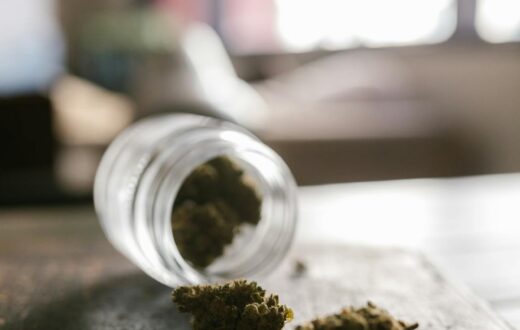Introduction to Chemdawg Auto
Chemdawg Auto is a renowned cannabis strain that has garnered acclaim for its distinctive flavor profile and high-yield potential. Originating from the famed Chemdawg lineage, this strain combines desirable traits from its predecessors while introducing the advantageous automatic flowering characteristics that appeal to both novice and experienced growers. The blend of genetics in Chemdawg Auto allows for cultivation flexibility, meaning it can thrive in various environmental conditions, making it particularly popular among those seeking reliability in their harvests.
The automatic flowering nature of Chemdawg Auto sets it apart from traditional cannabis strains, which require specific light cycles to trigger flowering. This feature not only simplifies the growing process but also allows growers to cultivate this strain in a relatively shorter timeframe, often leading to more frequent harvests. Consequently, it has become a favored choice for those looking to maximize their yields while minimizing the waiting period associated with photoperiod strains.
Moreover, the unique flavor of Chemdawg Auto is a significant draw for many cannabis enthusiasts. With a combination of diesel-like aromas and hints of earthiness, this strain offers a complex sensory experience, appealing to connoisseurs and casual users alike. The high from Chemdawg Auto is often described as uplifting and cerebral, striking a perfect balance for those seeking both relaxation and stimulation. As a result, cultivating Chemdawg Auto not only satisfies the grower’s desire for a bountiful harvest but also provides a product that delights consumers.
In summary, the introduction of Chemdawg Auto into the cannabis cultivation arena has redefined expectations for many growers. Its automatic flowering capability, coupled with a robust flavor profile and high yield potential, positions it as a staple strain in both home and commercial grow operations. As we delve deeper into the cultivation tips and techniques for this exceptional strain, understanding its origins and characteristics will provide a solid foundation for successful growth.
Understanding the Genetics of Chemdawg Auto
The Chemdawg Auto strain embodies a fascinating blend of genetics that contributes to its unique characteristics, making it a favored choice among cannabis growers. At its core, Chemdawg Auto is derived from the original Chemdawg lineage, which has long been celebrated for its potency and distinctive flavor profile. The genetic makeup of this strain reflects its hybrid nature, combining the best traits of its Indica and Sativa descendants.
The precise lineage of Chemdawg is somewhat clouded in mystery, but it is widely accepted that it originated from a cross between the well-regarded Chemdawg and ruderalis genetics. This meticulous breeding process is pivotal in crafting an autoflowering variant; by incorporating the traits of ruderalis, growers can cultivate Chemdawg Auto regardless of light cycles. As a result, understanding how to grow Chemdawg Auto becomes even more straightforward, as these plants transition from the vegetative to flowering stage autonomously.
Furthermore, the inclusion of ruderalis genetics not only contributes to the autoflowering capability but also enhances the resilience of the plant against various environmental factors. Chemdawg Auto typically exhibits robust growth patterns, a manageable height, and a commendable yield. The fusion of Chemdawg’s potent effects with the reliability of autoflowering features establishes this strain as an excellent choice for both novice and experienced cultivators.
In appreciating the genetic lineage of Chemdawg Auto, growers can gain insights into what makes this strain a staple in any cannabis garden. Familiarity with the characteristics inherited from its parent strains enables cultivators to tailor their growing practices, optimizing conditions to ensure healthy and bountiful harvests. Overall, understanding these genetics fosters a deeper appreciation for the cultivation process associated with Chemdawg Auto.
Optimal Growing Conditions for Chemdawg Auto
Creating the right environment is crucial for successfully learning how to grow Chemdawg Auto, as it significantly affects the plant’s overall health, growth pace, and yield potential. To achieve optimal growth, certain factors such as temperature, humidity, light cycles, and growing medium must be carefully managed.
Firstly, temperature plays a vital role in the growth process of Chemdawg Auto. The ideal temperature range for this strain is between 70°F to 85°F (21°C to 29°C) during the daytime. Nighttime temperatures should be slightly cooler but not drop below 60°F (15°C). Maintaining a consistent temperature within this range helps facilitate metabolism and nutrient absorption, which are crucial for healthy growth.
Humidity is another critical factor. During the seedling and vegetative stages, Chemdawg Auto thrives in higher humidity levels, around 65% to 70%. However, as the plant transitions into the flowering stage, reducing humidity to about 40% to 50% will help prevent mold and mildew growth, which can jeopardize your crop. Monitoring humidity levels is essential for creating a balanced growing environment.
When it comes to light cycles, Chemdawg Auto is a versatile strain that benefits from an 18/6 light/dark cycle during its vegetative phase and can be switched to a 12/12 cycle for its flowering phase. However, many growers prefer to keep it under continuous light for the entire cycle, as it encourages more aggressive growth, making it easier to learn how to grow Chemdawg Auto successfully.
Finally, selecting the right growing medium is paramount. Chemdawg Auto can flourish in both soil and hydroponic systems. Soil provides necessary nutrients and facilitates a robust microenvironment, while hydroponics offers greater control over nutrient delivery, often resulting in faster growth and larger yields. The choice between these methods depends on the grower’s preference and experience level, but both can yield excellent results when managed appropriately.
Nutrients and Fertilizers: Feeding Chemdawg Auto
Understanding the nutritional requirements of Chemdawg Auto is crucial for optimal growth and yield. This strain has a distinct life cycle characterized by three primary stages: seedling, vegetative, and flowering stages. Each phase has specific nutrient needs that must be addressed to ensure healthy plants and a bountiful harvest.
During the seedling stage, Chemdawg Auto requires minimal nutrients. A light feeding with a high-quality seedling mix, such as a base nutrient solution low in nitrogen, is recommended. This helps prevent nutrient burn, which can easily occur at this delicate stage. Soil amendments like mycorrhizae can also promote root health. Watering should be done carefully, ensuring the soil remains moist but not saturated.
As the plants transition into the vegetative stage, their nutrient needs increase. This stage is characterized by active growth, requiring a balanced fertilizer that is higher in nitrogen to support leaf and stem development. A typical N-P-K (nitrogen, phosphorus, potassium) ratio of 3:1:2 is beneficial. Additionally, incorporating supplements such as calcium and magnesium will support strong cell structure and overall plant vigor. Implementing a feeding schedule that gradually increases nutrient strength is wise to avoid overwhelming the plants.
During the flowering stage, Chemdawg Auto should be fed with a bloom nutrient formula that is higher in phosphorus and potassium. This N-P-K ratio of around 1:4:5 can enhance flower development, resulting in larger, denser buds. It’s equally important to monitor for any signs of deficiencies, such as yellowing leaves or poor bud formation, which may signal a need for micronutrients or adjustments in the feeding regimen. Regular checks can help identify and rectify these issues early in the flowering phase, ensuring the plants remain healthy through to harvest.
Watering Techniques: Keeping Chemdawg Auto Hydrated
Effective watering techniques are crucial for the successful growth of Chemdawg Auto. It is imperative to maintain a proper balance between over-watering and under-watering, as both can severely impact the growth and health of the plants. Over-watering can lead to root rot and nutrient deficiencies, while under-watering can cause stress and stunt growth. A grower should observe the soil moisture regularly to establish an effective watering schedule that meets the specific needs of Chemdawg Auto.
One recommended approach is to utilize a moisture meter to accurately gauge the levels of soil moisture before deciding to water. The goal is to ensure the soil remains consistently moist but not soggy. The preferred moisture level will vary based on the growth stage of the plant; for instance, Chemdawg Auto seedlings might require less water compared to mature plants. Regular checks will aid in understanding how quickly the soil drains and the needs of the plants.
Maintaining appropriate pH levels is another vital aspect of effective watering techniques. The optimal pH range for Chemdawg Auto is between 6.0 and 7.0. This range ensures that the roots can efficiently absorb essential nutrients from the soil. Growers should regularly test the water’s pH level before application, as fluctuations can cause unforeseen issues affecting plant health and growth.
When it comes to application methods, both hand watering and drip irrigation systems can be effective. Hand watering allows for greater control over each plant’s individual needs, whereas drip systems can provide a more consistent and automated approach. Whichever method is chosen, the key is to ensure that Chemdawg Auto receives the appropriate amount of water, promoting healthy growth and aiding in achieving optimal yields.
Pest and Disease Management for Chemdawg Auto
Effective pest and disease management is critical for cultivating healthy Chemdawg Auto plants and achieving optimal yields. Understanding potential threats associated with the cultivation of this strain helps growers take proactive measures to safeguard their crops. Common pests include aphids, spider mites, and thrips, all of which can significantly undermine plant health if left unchecked. Identifying these pests early on is crucial; look for signs such as discolored leaves, webbing, or stunted growth which often indicate an infestation. Regular inspections of the plants can help in spotting these indicators before they escalate into a larger issue.
In addition to pests, various diseases can pose a significant threat to Chemdawg Auto plants. Fungal infections such as powdery mildew and root rot can wreak havoc, particularly in humid conditions. Spotting these diseases early can make a considerable difference in managing their spread. Signs to watch for include white powdery spots on leaves or rotten roots which can be confirmed by examining the plant’s root system.
To prevent these issues, maintaining optimal growing conditions is essential. Ensure adequate air circulation, proper watering practices, and appropriate humidity levels to create an environment less susceptible to pests and diseases. Employing companion planting techniques or integrating beneficial insects such as ladybugs can serve as a natural deterrent against common pests. Additionally, organic insecticides and fungicides may be used as a solution when infestations occur; however, always ensure any products utilized are safe for cannabis plants and compliant with local regulations.
By establishing a thorough pest management plan and staying vigilant, growers can enhance the overall health of Chemdawg Auto plants. A proactive approach not only mitigates risks but also maximizes the strain’s yield potential, ensuring a successful harvest in the long run.
Harvesting Chemdawg Auto: When and How
Knowing when and how to harvest Chemdawg Auto is crucial for maximizing yield and ensuring that the final product possesses optimal potency and flavor. The right timing can significantly influence the quality of your buds. Generally, the ideal time to harvest Chemdawg Auto is when approximately 70-80% of the pistils have changed color from white to a reddish-brown hue. This color change indicates that the plant has reached its peak potency. Additionally, closely monitoring the trichomes can provide valuable insight; a milky appearance with some amber trichomes suggests that the plant is ready for harvest, achieving a balance between euphoric and relaxing effects.
Once you determine that your Chemdawg Auto is ripe for harvest, the next steps involve proper cutting and trimming techniques. Carefully use sharp pruning shears to cut the branches, ensuring you retain as much plant material as possible to reduce stress on the remaining plant. It is advisable to harvest in the early morning when the temperature is cooler and the plants are more resilient. This practice helps in retaining flavor and essential oils found in the buds.
After cutting the branches, the buds should be trimmed to remove excess leaves. This not only enhances the overall appearance but also improves airflow during the curing process. Aim to leave a small amount of sugar leaf for flavor retention. Following trimming, hang the branches upside down in a dark, well-ventilated area to begin drying. This process typically takes about 5 to 10 days, depending on environmental conditions. Post-drying, the curing process takes place, where buds are placed in airtight containers, checked regularly to prevent mold, and stirred to ensure even moisture distribution. This final step is essential for developing the rich flavors associated with Chemdawg Auto, enhancing the overall user experience.
Post-Harvest Care and Storage of Chemdawg Auto
Once the Chemdawg Auto plants have reached maturity and the buds are ready for harvest, it is essential to implement effective post-harvest care and storage practices to maintain their quality, flavor, and potency. The initial step after harvesting is to trim the buds appropriately. This involves removing any excess leaves and stems to ensure that only the flowering buds remain. Proper trimming not only enhances the aesthetic appearance of the buds but also aids in the curing process by facilitating airflow around the buds.
Curing is a crucial stage in developing the desired flavor and potency of Chemdawg Auto. This process typically involves placing the trimmed buds in airtight glass jars after they have been dried to a level of approximately 60% moisture. It is advisable to fill the jars only up to three-quarters of their capacity to allow for adequate airflow. During the curing phase, it is beneficial to open the jars for a few minutes each day, allowing fresh air to circulate and any remaining moisture to escape. This practice, known as “burping,” helps to prevent the growth of mold and ensures even curing.
Proper storage is key to preserving the vibrancy and effectiveness of Chemdawg Auto buds long term. Once cured, the buds should be stored in a cool, dark space to protect them from light and heat, both of which can degrade cannabis quality. Ideal storage containers include glass jars or vacuum-sealed bags, as these help maintain humidity levels while protecting against air exposure. Maintaining a stable environment will ensure that the flavor, aroma, and potency remain intact. By following these post-harvest care and storage practices carefully, growers can maximize the benefits of their Chemdawg Auto harvest, ensuring a satisfying experience for consumers.
Conclusion: Enjoying the Fruits of Your Labor
Successfully cultivating Chemdawg Auto can be a rewarding experience, culminating in a bounty of high-quality, aromatic buds. Throughout this guide, we have explored the essential steps needed to grow Chemdawg Auto, covering aspects such as optimal light conditions, nutrient requirements, and necessary environmental factors. By adhering to these guidelines, growers can provide the ideal conditions to foster robust plant growth and ultimately enhance their yield.
From the germination stage to harvesting, each phase plays a crucial role in determining the final product’s quality. Attention to detail alongside a sound understanding of how to grow Chemdawg Auto allows cultivators to maximize their output while minimizing common pitfalls. Notably, keeping a close watch on the plants’ health, ensuring adequate pH levels, and managing watering schedules can significantly influence the end result.
The flavor profile and effects of Chemdawg Auto contribute to its popularity, with many growers appreciating its balance of potency and unique terpenes. Once the harvest is complete, and after a prudent curing process, the rewards of your labor become evident with the rich aroma and stellar smoke experience. As you delve into the cultivation of Chemdawg Auto, remember that patience and diligence are integral components of a successful yield.
We encourage all growers to utilize the insights shared in this guide to enhance their cultivation practices. The journey of growing cannabis can be as enriching as the end product. Embrace the process, and you will be able to savor the fruits of your labor with pride. Ultimately, the knowledge gained will pave the way for future endeavors in cannabis cultivation, leading to even greater satisfaction and success in growing Chemdawg Auto.













